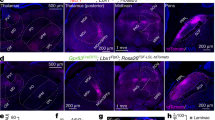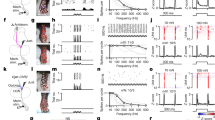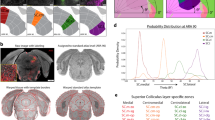Abstract
Somatic sensory information, such as touch, pressure, pain and body position, is conveyed to the mammalian thalamus and ultimately the cerebral cortex along three major ascending pathways in the spinal cord: (1) the dorsal column medial lemniscal (DCML) system, (2) the ventral column (VC) system, including the ‘neospinothalamic’, ‘palaeospinothalamic’ and spinoreticular tracts, and (3) the spino-cervico-lemniscal (SCL) system1,2. The phylogenetically recent DCML system has been traditionally viewed as an exclusive and homogeneous one-to-one relay of somatic sensory information to the thalamic ventralis posterolateralis nucleus. The emerging evidence, however, shows the gracile and cuneate nuclei as non-homogeneous structures which contain neurones that are subject to many kinds of central and peripheral influences, and which include neurones that do not project to the thalamus3. The relation of the ascending spinal pathways to the brain stem reticular formation (RF) is of particular interest in view of the numerous important functions subserved by this region. The spinal input into the RF is generally considered to reach it exclusively through the VC4. In view of their intraspinal connections5–8, it is difficult to separate and interact the three ascending spinal pathways. We now demonstrate a DCML input into the gigantocellular nucleus (Rgc) of the medial medullary RF in cats, and show inhibitory as well as excitatory interactions between DCML and VC tracts in RF cells. We used a combination of careful spinal surgical lesions aimed at disconnecting the DCML from the other afferent systems and of localized spinal and peripheral stimulations. Persistence of the response of Rgc neurones to DCML stimulation in decerebrate and decerebellate cats rules out the possibility of descending activation via a feedback loop from the cerebral and cerebellar cortices. In view of the possible involvement of Rgc in processing nociceptive input, these findings are of interest to our understanding of the DCML system in somatosensory function and, in particular, pain mechanisms.
This is a preview of subscription content, access via your institution
Access options
Subscribe to this journal
Receive 51 print issues and online access
$199.00 per year
only $3.90 per issue
Buy this article
- Purchase on Springer Link
- Instant access to full article PDF
Prices may be subject to local taxes which are calculated during checkout
Similar content being viewed by others
References
Ruch, T. C. in Physiology and Biophysics. The Brain and Neural Function (eds Ruch, T. C. & Patton, H. D.) 201–271 (Saunders, Philadelphia, 1979).
Wall, P. D. & Dubner, R. A. Rev. Physiol. 34, 315–335 (1972).
Norton, A. C. & Kruger, L. The Dorsal Column System of the Spinal Cord. Its Anatomy, Physiology, Phytogeny and Sensory Function (Brain Information Service, Los Angeles, 1973).
Mehler, W. R. Ann. N. Y. Acad. Sci. 167, 424–468 (1969).
Brown, A. G. & Martin, H. F. J. Physiol., Lond. 224, 34P–35P (1972).
Dart, A. M. & Gordon, G. Brain Res. 58, 61–68 (1973).
Gordon, G. & Grant, G. Acta physiol. scand. 84, 30A–31A (1972).
Foreman, R. D., Beall, J. E., Applebaum, A. E., Coulter, J. D. & Willis, W. D. J. Neurophysiol. 39, 534–546 (1976).
Jabbur, S. J., Baker, M. A. & Towe, A. L. Expl Neurol. 36, 213–238 (1972).
Casey, K. L. Expl Neurol. 25, 35–56 (1969).
Pearl, G. S. & Anderson, K. V. Expl Neurol. 57, 307–321 (1977).
Schetter, A. G. & Atkinson, J. R. Expl Neurol. 54, 185–198 (1977).
Hand, P. & Liu, C. N. Anat. Rec. 154, 353–354 (1966).
Hazlett, J. C., Dom, R. & Martin, G. F. J. comp. Neurol. 146, 95–118 (1972).
Jane, J. A. & Schroeder, D. M. Expl Neurol. 30, 1–17 (1971); Schroeder, D. M. & Jane, J. A. J. comp. Neurol. 142, 309–350 (1971).
Valverde, F. J. comp. Neurol. 116, 71–99 (1961); Anat. Rec. 151, 496 (1965); Z. Zellforsch. microsk. Anat. 71, 297–363 (1966).
Rustioni, A. & Macchi, G. J. comp. Neurol. 134, 113–126 (1968).
Berkley, K. J. & Worden, I. G. J. comp. Neurol. 163, 285–304 (1975).
Crosby, E. C., Humphrey, T. & Lauer, E. W. Correlative Anatomy of the Nervous System (Macmillan, New York, 1962).
Blomqvist, A. & Westman, J. Brain Res. 111, 407–410 (1976).
Odutola, A. B. Expl Neurol. 54, 54–59 (1977).
Sotgiu, M. L. & Margnelli, M. Brain Res. 103, 443–453 (1976).
Sotgiu, M. L. & Marini, G. Brain Res. 128, 341–345 (1977).
Hand, P. J. & Van Winkle, T. J. comp. Neurol. 171, 83–110 (1977).
Dennis, S. G. & Melzack, R. Pain 4, 97–132 (1977).
Author information
Authors and Affiliations
Rights and permissions
About this article
Cite this article
Salibi, N., Saadé, N., Banna, N. et al. Dorsal column input into the reticular formation. Nature 288, 481–483 (1980). https://doi.org/10.1038/288481a0
Received:
Accepted:
Issue Date:
DOI: https://doi.org/10.1038/288481a0
This article is cited by
-
The role of the dorsolateral funiculi in the pain relieving effect of spinal cord stimulation: a study in a rat model of neuropathic pain
Experimental Brain Research (2015)
-
Spinal Cord Stimulation: Neurophysiological and Neurochemical Mechanisms of Action
Current Pain and Headache Reports (2012)
-
Primary afferent projections to the spinal cord and the dorsal column nuclear complex in the turtle Pseudemys
Anatomy and Embryology (1983)
Comments
By submitting a comment you agree to abide by our Terms and Community Guidelines. If you find something abusive or that does not comply with our terms or guidelines please flag it as inappropriate.



